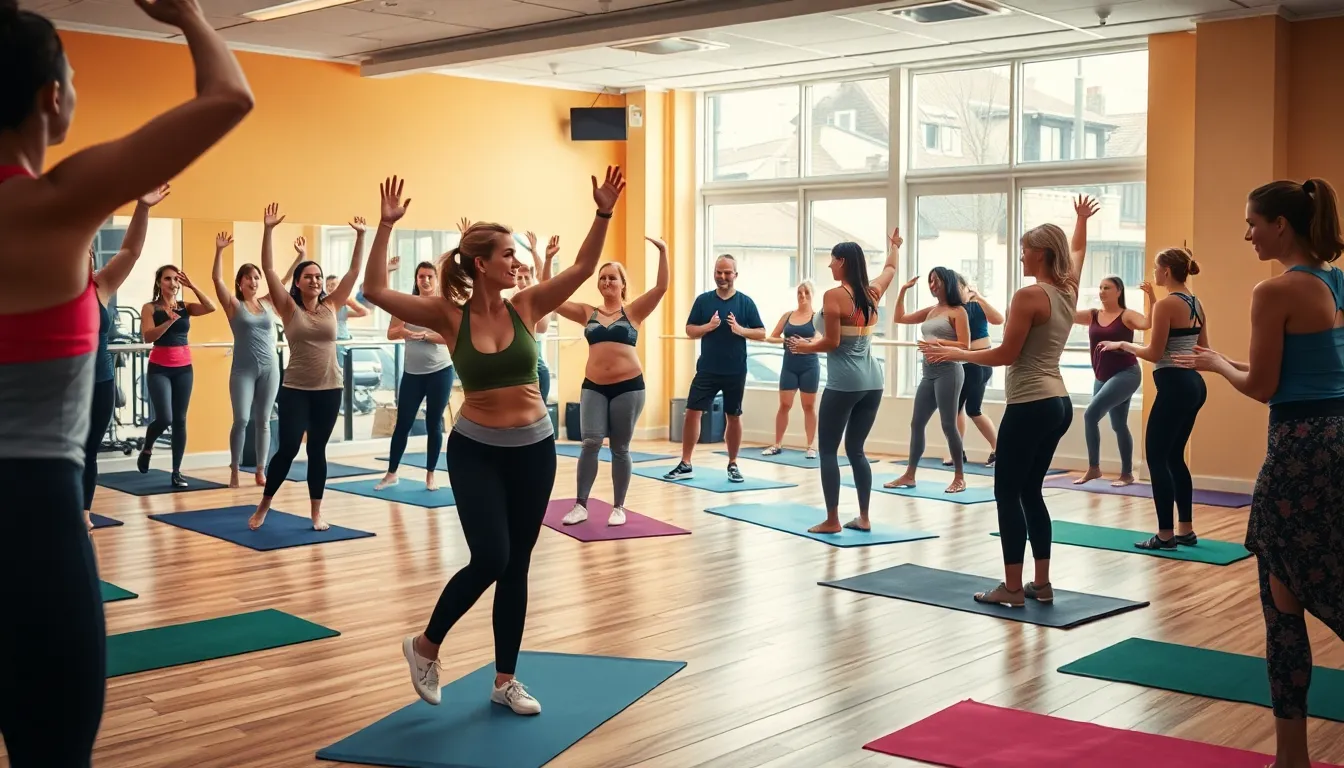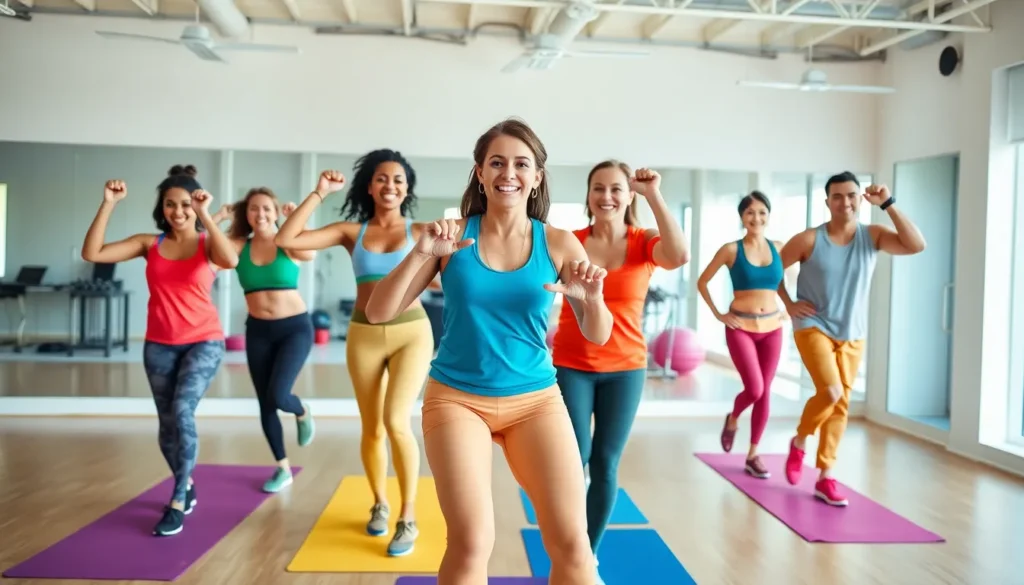In a world where fitness can feel like a solo mission, group fitness classes offer a refreshing twist. Imagine sweating it out with a crew of equally determined individuals, all while trying not to trip over each other’s feet. It’s like a dance party, but with more burpees and fewer questionable dance moves.
Table of Contents
ToggleWhat Is Group Fitness?
Group fitness combines exercise with the support of others, creating a shared environment for physical activity. In these classes, participants engage in structured workouts led by trained instructors. Participants often discover new exercises they might not try alone, expanding their fitness horizons.
Classes feature various styles, such as yoga, cycling, or high-intensity interval training (HIIT). Group fitness promotes accountability among members, motivating individuals to attend regularly. The social interaction enhances enjoyment, making workouts more satisfying.
Energetic music typically fills the room, setting a lively atmosphere. This ambiance can invigorate attendees, pushing them to perform at their best. Attendees may also find that working out in a group fosters a sense of belonging, creating friendships based on shared fitness goals.
Fitness levels in these classes vary, accommodating everyone from beginners to advanced athletes. Modifications often allow participants to tailor exercises to suit their abilities. This inclusivity attracts a wide range of individuals, reinforcing the community aspect.
The group dynamic increases motivation levels, which can lead to improved consistency. Research indicates that individuals in group settings often achieve better results than those who exercise alone. Overall, group fitness embodies a vibrant blend of community and effective workouts, appealing to many seeking a supportive fitness environment.
Benefits of Group Fitness

Group fitness classes provide significant advantages that enhance both physical and mental well-being. Engaging in structured workouts alongside others promotes a supportive community atmosphere.
Physical Benefits
Participants experience diverse workouts that target various muscle groups. Structured classes include options such as yoga, cycling, and HIIT, ensuring comprehensive fitness. Modifications catered to different abilities allow every individual to benefit, regardless of their starting point. Improved strength, endurance, and flexibility frequently result from consistent attendance in group sessions. Additionally, social interactions encourage individuals to challenge themselves more than they might alone, often leading to faster progress.
Mental Benefits
Engaging in group fitness fosters motivation and accountability. The shared experience builds camaraderie, reducing feelings of isolation commonly associated with exercise. Participants often report lower stress levels due to the uplifting atmosphere. High-energy music and enthusiastic instructors cultivate enjoyment, making workouts feel less like a chore and more like a celebration. This vibrant environment helps in developing new friendships based on mutual goals, significantly enhancing overall mental health. Increased self-confidence frequently follows, as individuals realize their capabilities alongside supportive peers.
Types of Group Fitness Classes
Group fitness encompasses various class formats, each tailored to meet specific workout goals and preferences. Here are some popular types of classes participants can explore.
High-Intensity Interval Training (HIIT)
HIIT classes focus on short bursts of intense exercise followed by brief rest periods. Participants engage in intervals that combine cardiovascular and strength exercises, maximizing calorie burn in a shorter time frame. Classes often include exercises like burpees, squats, and sprints. Due to the variable intensity, individual fitness levels can thrive within the group dynamic. The energetic atmosphere maintains motivation and encourages participants to push their limits, promoting endurance and strength gains.
Yoga and Pilates
Yoga and Pilates classes emphasize flexibility, balance, and core strength. Each discipline offers unique benefits; yoga integrates mindfulness and breath control, while Pilates focuses on core stability and alignment. During sessions, participants execute a series of poses or controlled movements designed to enhance physical awareness. Modifications cater to different abilities and gradually deepen participants’ skills. Regular attendance promotes relaxation and stress reduction, along with improved body awareness and posture.
Dance and Zumba
Dance and Zumba classes provide fun, energetic workouts focusing on rhythm and movement. Participants follow instructors through choreographed routines to upbeat music, making workouts feel more like a dance party than exercise. Classes cater to various dance styles, offering something for everyone, from hip-hop to Latin-inspired routines. Engaging in these classes fosters a sense of community, encouraging participants to express themselves while improving cardiovascular fitness and coordination.
Strength Training
Strength training classes concentrate on building muscle and improving overall strength using weights and resistance bands. Typically, sessions include exercises that target major muscle groups, such as squats, deadlifts, and bench presses. Instructors guide participants through proper techniques, ensuring safety and effectiveness. Group settings promote camaraderie as individuals motivate one another to challenge themselves progressively. Regular strength training enhances muscle tone and metabolic rate, supporting participants’ overall fitness journeys.
Finding the Right Group Fitness Class
Choosing the right group fitness class involves understanding personal needs and preferences. Factors like fitness level and workout preferences significantly influence this decision.
Assessing Your Fitness Level
Recognizing individual fitness levels helps in selecting suitable classes. Beginners might find introductory classes beneficial as they offer fundamental techniques. Intermediate participants can explore moderate-intensity sessions that challenge their endurance. Advanced individuals may prefer high-intensity workouts, pushing their limits. Prior experience also significantly influences choices. Individuals with specific goals, such as weight loss or muscle gain, should look for classes targeting those objectives. Evaluating one’s comfort level ensures engagement and enjoyment.
Choosing the Right Environment
Selecting a motivating environment enhances the group fitness experience. Active studios resonate with energy, creating an inviting atmosphere. Additionally, the instructor’s teaching style plays a crucial role. Those seeking encouragement might prefer upbeat, energetic instructors who inspire participants. Others may opt for a more focused, technique-driven approach. The class size also impacts the experience; smaller groups may offer personalized attention. Considering class time and location helps maintain consistency in attendance. Ultimately, finding a setting that aligns with individual preferences fosters a fulfilling fitness journey.
Group fitness offers an engaging and supportive way to achieve fitness goals while fostering community connections. The diverse range of classes ensures there’s something for everyone, regardless of fitness level. Participants not only improve their physical health but also experience mental benefits, such as increased motivation and reduced stress.
The camaraderie built in these classes transforms workouts into enjoyable social events, encouraging individuals to push their limits. By choosing the right class and environment, anyone can embark on a fulfilling fitness journey that promotes both personal growth and lasting friendships. Embracing group fitness could be the key to a healthier and happier lifestyle.





